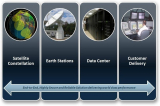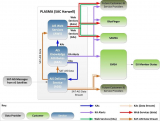
-
StatusOngoing
-
Status date2014-06-24
Objectives
The purpose of the PLASMA project is two-fold:
- Based on new data centre infrastructure to be operated from the UK’s Satellite Applications Catapult, implement and demonstrate three key services:
- ‘AIS Knowledge Attributes’ (AKA) Service- provides end users with ‘Knowledge Attributes’ (KAs), i.e. enhanced/value-add information and alerts derived from analysing base AIS message data
- ‘AIS Web Services’ (AWS) - provides on-demand access to both base AIS data and KAs, via OGC geospatial web services.
- ‘SAT-AIS Distribution Service’ (ADS) - supports end user applications by routinely ingesting, managing and distributing base AIS message data from exactEarth’s AIS satellites.
- Provide routine SAT-AIS services direct to EMSA, Europe’s key maritime organisation, through the integration of PLASMA’s outputs into EMSA’s IMDatE. This will allow the provisioning of pre-operational AIS advanced services to EMSA member states.
Longer term objectives are:
- Provide a SAT-AIS service resource for use by institutional and commercial European, Middle Eastern and African maritime users and information service developers/providers.
- Provide a physical facility for the raw data processing of future SAT-AIS missions planned under the ESA Integrated Application Programme.
- Develop, in partnership with end users and application/service developers, new value-added information services.
- Encourage other third-party AIS providers to use PLASMA as a data centre for disseminating their data to end users.
Challenges
- Use of the ‘Climate and Environmental Monitoring from Space’(CEMS) facility for physical infrastructure hosting
- Integration of PLASMA services into users’ legacy systems
- Development of the knowledge attributes (KA) rules engine as the heart of the AKA Service.
- Development and demonstration of a number of example KAs that will demonstrate the power of the AKA Service.
Benefits
- Fulfilling the needs of our end customers by providing them with:
- an AKA service that creates value-added information in the form of ‘knowledge attributes’ derived from post-processing SAT-AIS messages. The AKA service is a powerful, cost effective and operationally efficient way for end users to be notified and then receive information of specific interest, without the need for them to analyse/filter all incoming AIS base data themselves.
- an AWS, which provides a number of on-demand geospatial web services to retrieve and analyse PLASMA-provided data and information, i.e. base AIS data and KAs. The AWS, which uses OGC standards, is a powerful and operationally efficient way of end users and third-party service developers selecting when and what data/information they wish to receive.
- an ADS, focussed on serving EMEA customers with stream-based base AIS messages - there are a number of users of AIS data who wish to be pushed every AIS message as soon it becomes available after any post-reception processing.
- Providing a rich underlying platform at the heart of the UK Satellite Applications Catapult to support the development of new maritime applications and services by 3rd party value-added service developers.
Features
As illustrated below, PLASMA will consist of three key data and information delivery services:
- Some customers will require ‘as soon as is available’ routine access to all received base / native AIS data, which they will then integrate into their own systems for their own subsequent higher-level processing needs. These data are ‘pushed’ to the customer, i.e. these would be uses of PLASMA’s ‘AIS Delivery Service’ (ADS).
- Some customers will be less concerned with the need to receive and handle every base/native AIS message provided for by the underlying data capture systems, and instead be more interested in investigating only those incoming data items / events of specific interest, and/or that potentially deviate from the norm, i.e. these would be users of PLASMA’s ‘AIS Knowledge Attributes’ (AKA) service.
- Some customers will not need to receive pushed routine low-level data/information feeds, but instead will ‘pull’ data and information on-demand as they or their systems require it. Additionally they view AIS data as geo-spatial information and wish to access/manipulate it using open geospatial standards, i.e. these would be users of PLASMA’s ‘AIS Web Services’ (AWS) component.
In the above diagram the proposed demonstration services are shown in blue and our customers in green, with the following end users using the demonstration services on the project:
- European Maritime Safety Agency (EMSA - www.emsa.europa.eu)
- BlueFinger (www.bluefinger.com)
- South Africa Maritime Safety Authority (SAMSA - www.samsa.org.za).
Plan
- Definition of the user requirements in coordination with EMSA, SAMSA and BlueFinger
- Definition of PLASMA service architecture
- Implementing the physical hardware and networking infrastructure at the Satellite Applications Catapult required to support Plasma’s core service offerings.
- Implement the following three core data and information services:
- ‘AIS Knowledge Attributes’ (AKA) Service
- ‘AIS Web Services’ (AWS)
- ‘SAT-AIS Distribution Service’ (ADS).
- Engage at all stages of the project with our demonstration end users, who are:
- the ‘European Maritime Safety Agency’ (EMSA)
- the ‘South African Maritime Safety Agency’ (SAMSA)
- BlueFinger, a UK commercial maritime information service provider
- Pre-operationally demonstrate these services through their use by our three end users
- Based the provision of feedback from our end users, formulate an operations plan that specifies how we will evolve the demonstration services to roll-out an operational capability.
- Throughout the project, iterate and refine a business planning exercise, and tie it to the operations plan at the end of the project.
Current status
- Users’ and system requirements have been defined and agreed by the end users.
- Project’s main BDR and CDR successfully completed
- Via the ADS, AIS service distribution is in demonstration mode with EMSA, which is routing the AIS services out to several member states which are currently participating in the IMDatE services pilot phase. EMSA are providing regular evaluation feedback.
- AKA service and AWS under development, with the aim for a first release at the end of August 2014.





